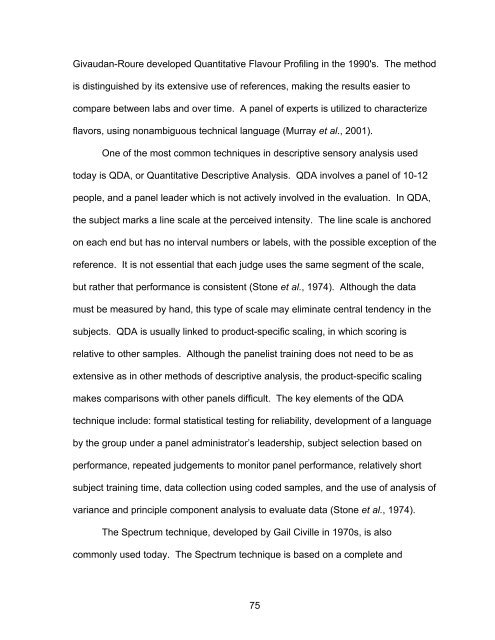Abstract SCHIRACK, ANDRIANA VAIS. The Effect of Microwave ...
Abstract SCHIRACK, ANDRIANA VAIS. The Effect of Microwave ...
Abstract SCHIRACK, ANDRIANA VAIS. The Effect of Microwave ...
Create successful ePaper yourself
Turn your PDF publications into a flip-book with our unique Google optimized e-Paper software.
Givaudan-Roure developed Quantitative Flavour Pr<strong>of</strong>iling in the 1990's. <strong>The</strong> method<br />
is distinguished by its extensive use <strong>of</strong> references, making the results easier to<br />
compare between labs and over time. A panel <strong>of</strong> experts is utilized to characterize<br />
flavors, using nonambiguous technical language (Murray et al., 2001).<br />
One <strong>of</strong> the most common techniques in descriptive sensory analysis used<br />
today is QDA, or Quantitative Descriptive Analysis. QDA involves a panel <strong>of</strong> 10-12<br />
people, and a panel leader which is not actively involved in the evaluation. In QDA,<br />
the subject marks a line scale at the perceived intensity. <strong>The</strong> line scale is anchored<br />
on each end but has no interval numbers or labels, with the possible exception <strong>of</strong> the<br />
reference. It is not essential that each judge uses the same segment <strong>of</strong> the scale,<br />
but rather that performance is consistent (Stone et al., 1974). Although the data<br />
must be measured by hand, this type <strong>of</strong> scale may eliminate central tendency in the<br />
subjects. QDA is usually linked to product-specific scaling, in which scoring is<br />
relative to other samples. Although the panelist training does not need to be as<br />
extensive as in other methods <strong>of</strong> descriptive analysis, the product-specific scaling<br />
makes comparisons with other panels difficult. <strong>The</strong> key elements <strong>of</strong> the QDA<br />
technique include: formal statistical testing for reliability, development <strong>of</strong> a language<br />
by the group under a panel administrator’s leadership, subject selection based on<br />
performance, repeated judgements to monitor panel performance, relatively short<br />
subject training time, data collection using coded samples, and the use <strong>of</strong> analysis <strong>of</strong><br />
variance and principle component analysis to evaluate data (Stone et al., 1974).<br />
<strong>The</strong> Spectrum technique, developed by Gail Civille in 1970s, is also<br />
commonly used today. <strong>The</strong> Spectrum technique is based on a complete and<br />
75

















